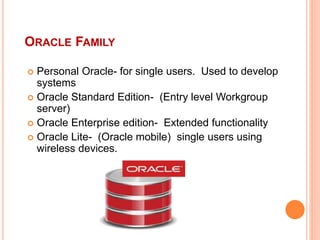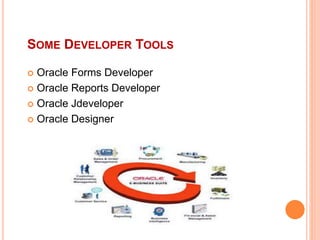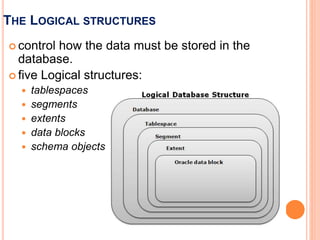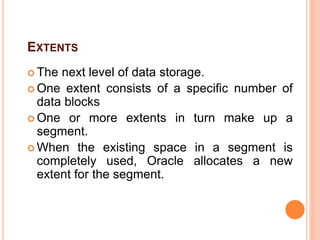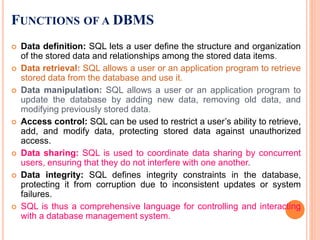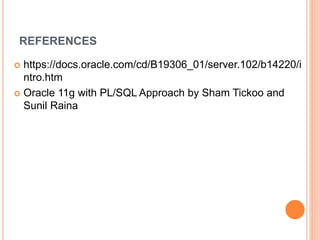Introduction to Oracle Database
- 2. ORACLE HISTORY Larry Ellison and his two friends and former co-workers, Bob Miner and Ed Oates, started a consultancy called Software Development Laboratories (SDL) in 1977. SDL developed the original version of the Oracle software. Developer Usage Oracle Database Architecture. An Oracle database is a collection of data treated as a unit. The purpose of a database is to store and retrieve related information. A database server is the key to solving the problems of information management. The i in oracle 8i and 9i stands for INTERNET and the g in 10g and 11g stands for GRID, because from 10g onwards oracle supports grid architecture. Meaning of i & g in Oracle databases Oracle released Oracle Database 12c into general availability July 1, 2013. According to Oracle, this is "the first database designed for the cloud.” Meaning of Oracle 12c
- 3. ORACLE HISTORY 1979 Oracle Release 2 1986 client/server relational database 1989 Oracle 6 1997 Oracle 8 (object relational) 1999 Oracle 8i (Java Virtual Machine) 2000 Oracle Application Server 2001 Oracle 9i database server
- 4. The major Oracle versions, with their latest patch-sets are: Oracle 7: ... - 7.3.4.5 Oracle 8: 8.0.3 - 8.0.6 Oracle 8i: 8.1.5.0 - 8.1.7.4 Oracle 9i (Release 1): 9.0.1.0 - 9.0.1.4 Oracle 9i (Release 2): 9.2.0.1 - 9.2.0.8 Oracle 10g (Release 1): 10.1.0.2 - 10.1.0.5 Oracle 10g (Release 2): 10.2.0.1 - 10.2.0.5 Oracle 11g (Release 1): 11.1.0.6 - 11.1.0.7 Oracle 11g (Release 2): 11.2.0.1 - 11.2.0.4 Oracle 12c (Release 1): 12.1.0.1 - 12.1.0.2.0 Note: If running on one of the above releases, it is recommended to always install the latest patch-set.
- 5. OVERVIEW OF ORACLE GRID ARCHITECTURE Grid computing is a new IT architecture that produces more resilient and lower cost enterprise information systems. With grid computing, groups of independent, modular hardware and software components can be connected and rejoined on demand to meet the changing needs of businesses. Benefits of Grid Computing Compared to other models of computing, IT systems designed and implemented in the grid style deliver higher quality of service, lower cost, and greater flexibility. Higher quality of service results from having no single point of failure, a robust security infrastructure, and centralized, policy-driven management. Lower costs derive from increasing the utilization of resources and dramatically reducing management and maintenance costs. Rather than dedicating a stack of software and hardware to a specific task, all resources are pooled and allocated on demand, thus eliminating under utilized capacity and redundant capabilities. Grid computing also enables the use of smaller individual hardware components, thus reducing the cost of each individual component and providing more flexibility to devote resources in accordance with changing needs.
- 6. ORACLE FAMILY Personal Oracle- for single users. Used to develop systems Oracle Standard Edition- (Entry level Workgroup server) Oracle Enterprise edition- Extended functionality Oracle Lite- (Oracle mobile) single users using wireless devices.
- 7. SOME DEVELOPER TOOLS Oracle Forms Developer Oracle Reports Developer Oracle Jdeveloper Oracle Designer
- 11. DATABASE STRUCTURE Logical structure - maps the data to the Physical structure. Physical structure -part of the operating system’s file structure. Memory structure - where all the processing takes place.
- 12. THE LOGICAL STRUCTURES control how the data must be stored in the database. five Logical structures: tablespaces segments extents data blocks schema objects
- 13. PHYSICAL STRUCTURES Parameter files Password files Datafiles Redo log files Control files
- 14. TABLESPACES A database is divided into logical storage units called Tablespaces. logical construct for arranging different types of data An Oracle database must have at least a system tablespace. It is recommended to have different tablespaces for user and system data.
- 15. SCHEMAS AND SCHEMA OBJECTS Collection of database objects Tables Views Sequences Indexes Procedures Functions Packages Triggers
- 16. DATA BLOCKS The smallest unit of Input/Output used by Oracle database. The size of data block for any database is fixed at the time of creation of the database; Some values of the data block size are 2KB, 8KB, 16KB, and 32KB. Oracle recommends a size of 8KB
- 17. EXTENTS The next level of data storage. One extent consists of a specific number of data blocks One or more extents in turn make up a segment. When the existing space in a segment is completely used, Oracle allocates a new extent for the segment.
- 18. SEGMENT A segment consists of a set of extents Each table’s data is stored in its own single segment. Each index’s data is stored in a single segment. More extents are automatically allocated by Oracle to a segment if its existing extents become full. The different types of segments are the data segments, index segments,rollback segments, and temporary segments.
- 19. PHYSICAL DATABASE STRUCTURE Password file - which contain the password information for all users. Parameter file - which contains all the important information necessary to start a database. Datafiles - which contain the application data being stored, as well as any data necessary to store user-IDs, passwords, and privileges. Redo log files - which store all the transactions made to the database. These files are also called transaction log files. Control files - which store information specifying the structure of the database,such as the name and time of creation of the database and the name and location of the datafiles.
- 20. SECURITY MECHANISMS Database users and schemas Privileges Roles Storage settings and quotas Resource limits Auditing
- 21. DATA ACCESS: SQL Data definition language (DDL) statements Data manipulation language (DML) statements Transaction control statements Session control statements System control statements Embedded SQL statements
- 22. TRANSACTIONS A transaction is a logical unit of work that comprises one or more SQL statement executed by a single user. According to the ANSI/ISO SQL standard, with which Oracle is compatible, a transaction begins with the user’s first executable SQL statement. A transaction ends when it is explicitly committed or rolled back.
- 24. DATA ACCESS: SQL Session Control Statements These statements let a user control the properties of the current session, including enabling and disabling roles and changing language settings. The two session control statements are ALTER SESSION and SET ROLE. System Control Statements These statements change the properties of the Oracle database instance. The only system control statement is ALTER SYSTEM. It lets users change settings, such as the minimum number of shared servers, kill a session, and perform other tasks. Embedded SQL Statements These statements incorporate DDL, DML, and transaction control statements in a procedural language program, such as those used with the Oracle precompilers. Examples include OPEN, CLOSE, FETCH, and EXECUTE
- 25. Overview of Data types Each column value and constant in a SQL statement has a data type, which is associated with a specific storage format, constraints, and a valid range of values. When you create a table, you must specify a datatype for each of its columns. Oracle provides the following built-in data types: Character datatypes Numeric datatypes DATE datatype LOB datatypes RAW and LONG RAW datatypes
- 26. Relational Model Concepts A Relation is a mathematical concept based on the ideas of sets The model was first proposed by Dr. E.F. Codd of IBM Research in 1970 in the following paper: – "A Relational Model for Large Shared Data Banks," Communications of the ACM (Association for Computing machinery), June 1970 The above paper caused a major revolution in the field of database management
- 27. FUNCTIONS OF A DBMS Data definition: SQL lets a user define the structure and organization of the stored data and relationships among the stored data items. Data retrieval: SQL allows a user or an application program to retrieve stored data from the database and use it. Data manipulation: SQL allows a user or an application program to update the database by adding new data, removing old data, and modifying previously stored data. Access control: SQL can be used to restrict a user’s ability to retrieve, add, and modify data, protecting stored data against unauthorized access. Data sharing: SQL is used to coordinate data sharing by concurrent users, ensuring that they do not interfere with one another. Data integrity: SQL defines integrity constraints in the database, protecting it from corruption due to inconsistent updates or system failures. SQL is thus a comprehensive language for controlling and interacting with a database management system.
- 28. Informal Definitions Informally, a relation looks like a table of values. A relation typically contains a set of rows. The data elements in each row represent certain facts that correspond to a real-world entity or relationship – In the formal model, rows are called tuples Each column has a column header that gives an indication of the meaning of the data items in that column – In the formal model, the column header is called an attribute name (or just attribute)
- 29. Example of a Relation
- 30. Relational Integrity Constraints Constraints are conditions that must hold on all valid relation states. There are three main types of constraints in the relational model: – Key constraints – Entity integrity constraints – Referential integrity constraints Another implicit constraint is the domain constraint – Every value in a tuple must be from the domain of its attribute (or it could be null, if allowed for that attribute)
- 31. STRUCTURED QUERY LANGUAGE SQL (Structured Query Language) is a database sub-language for querying and modifying relational databases. It was developed by IBM Research in the mid 70's and standardized by ANSI in 1986. Relational Model defines two root languages for accessing a relational database -- Relational Algebra and Relational Calculus.
- 32. REFERENCES https://docs.oracle.com/cd/B19306_01/server.102/b14220/i ntro.htm Oracle 11g with PL/SQL Approach by Sham Tickoo and Sunil Raina
- 33. PRACTICAL IMPLEMENTATION OF SQL COMMANDS AND ITS VARIOUS TYPES WILL BE PERFORMED IN LABS





